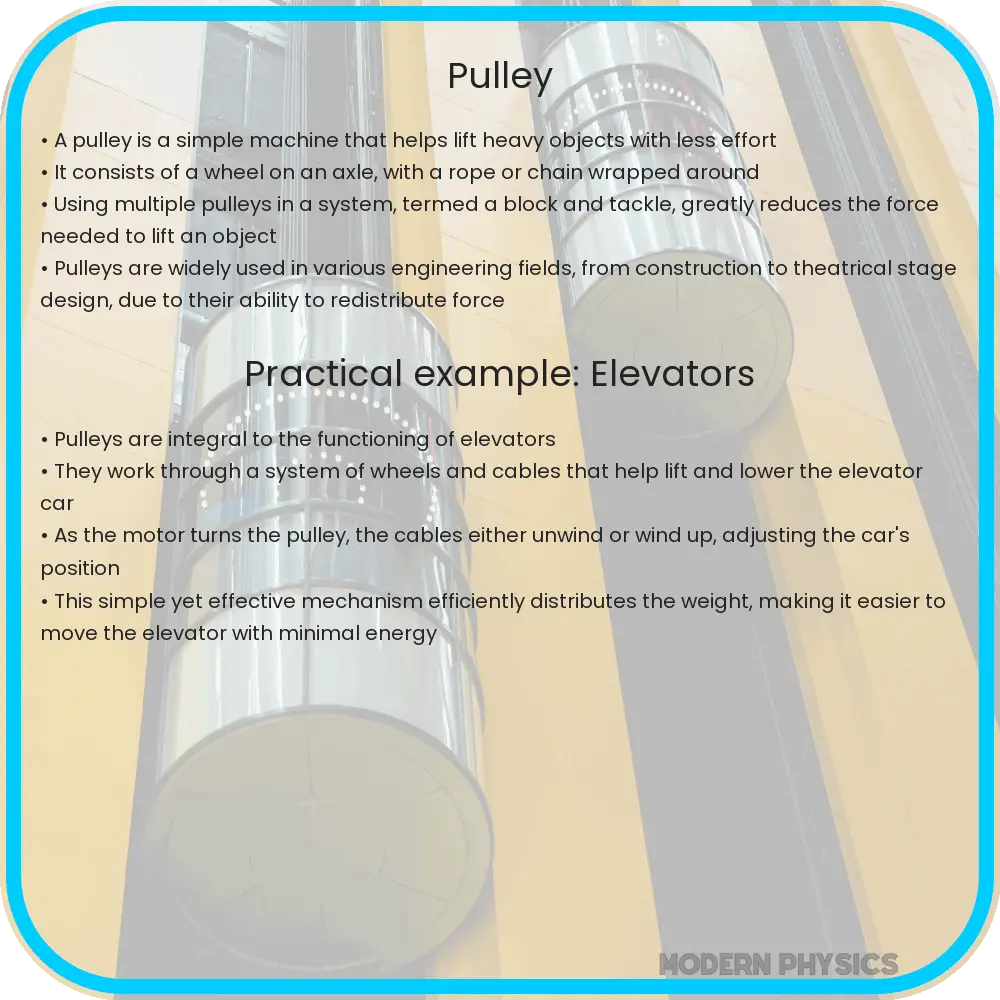Learn about pulley systems, their mechanics, efficiency, and force dynamics to understand how they reduce effort and increase performance in various applications.

Understanding Pulley Systems: Efficiency, Mechanics, and Force Dynamics
Pulleys are simple machines used to lift loads, apply forces, and transmit power. A pulley system typically consists of a wheel on an axle or shaft that supports movement of a cable or belt along its circumference. They are fundamental in engineering, physics, and everyday applications due to their ability to modify the direction and magnitude of forces.
Basic Mechanics of Pulleys
The basic idea behind a pulley system is mechanical advantage. This is defined as the ratio of the output force the system delivers to the input force exerted, which often allows a smaller force to lift a heavier load. This concept helps quantify the effectiveness of a pulley in reducing the effort needed to do work.
- Fixed Pulley: This type of pulley is attached to a structure and rotates around its axis. The mechanical advantage is 1, meaning there is no gain in force, but it changes the direction of the force applied.
- Movable Pulley: Attached to the load being lifted, it moves with the load. A movable pulley halves the amount of force needed to lift the load and has a mechanical advantage of 2.
- Compound Pulley: A system that comprises both fixed and movable pulleys to further reduce the effort needed. The mechanical advantage increases with the number of pulleys used in the system.
A common application of pulley systems is in cranes, elevators, and theater curtains, where they provide essential functionality with simple mechanics.
Efficiency of Pulley Systems
Efficiency in pulley systems is crucial as it impacts the energy conservation and performance of the system. Efficiency (%E) can be calculated with the formula:
\[
%E = \left(\frac{Output\ Power}{Input\ Power}\right) * 100
\]
Several factors affect the efficiency of a pulley system:
- Friction: Particularly between the rope and the pulley. Greater friction means more energy is wasted, reducing efficiency.
- Weight of the Pulleys: Heavier pulleys require more force to move, which can reduce overall system efficiency.
- Quality of the Rope: Stiff or inelastic ropes can absorb some of the energy being used to move the load.
Understanding these factors helps in designing more effective pulley systems, whether for industrial use or everyday applications.
Force Dynamics in Pulley Systems
The dynamics of forces in pulley systems can be analyzed using Newton’s Laws of Motion. The primary equation used to determine the force Fout needed to lift a load Fin considering friction and the efficiency of the pulley system is given by:
\[
F_{out} = \frac{F_{in}}{(n * \%E)}
\]
where
- \(n\) is the number of ropes supporting the load (indicative of the number of movable pulleys), and
- \(%E\) is the efficiency of the pulley system.
This equation highlights how both the number of pulleys and the system’s efficiency influence the effort required to lift a load. Investing in high-quality components and proper maintenance are key strategies to maximise the efficiency and functionality of pulley systems.
Real-World Applications of Pulley Systems
Pulley systems find diverse applications in the modern world, from small-scale devices to larger industrial machinery. Here are a few notable examples:
- Construction Sites: Tower cranes used at construction sites frequently utilize compound pulleys to lift heavy materials to considerable heights, demonstrating both the power and utility of pulleys in building infrastructures.
- Fitness Equipment: Gym machines often incorporate pulleys to vary the load and resistance, allowing for a wide range of exercises tailored to different strength levels.
- Automotive Systems: The serpentine belt in a car engine is driven by a system of pulleys that operate the alternator, air conditioning compressor, and other components, showcasing the efficiency of pulley systems in power transmission.
Each of these applications underlines how pulleys enhance functionality by making tasks easier and processes more efficient. This vast range of applications showcases the flexibility and indispensability of pulley systems in technology and daily life.
Conclusion
Pulley systems are classic examples of how fundamental physics principles can be applied to perform work efficiently and effectively in a variety of settings. From simple fixed pulleys altering the direction of forces, to complex compound pulley setups reducing the effort needed in industrial applications, these systems play a crucial role in mechanical provision and innovation. By understanding the basic mechanics, efficiency factors, and force dynamics of pulleys, users can better utilize and optimize these systems for their specific needs. As technology progresses, the pulley remains a vital component in machinery and devices, reflective of the enduring significance of classical mechanical principles in modern engineering.
Ultimately, the study and application of pulley systems not only enhance our ability to undertake a plethora of tasks but also continually push us towards more innovative and efficient engineering solutions. Whether in simple daily gadgets or large-scale industrial machinery, the humble pulley proves that sometimes the most straightforward solutions are also the most powerful.
